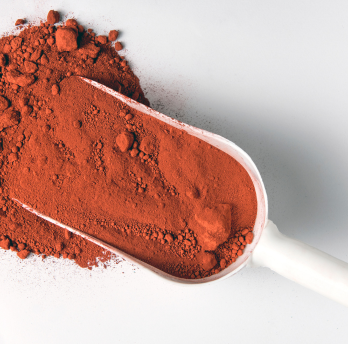Red Iron Oxides
Product Details:
| Material |
Red Iron Oxide |
| Brand |
Selox |
| Color |
Red/ Yellow/ Black/ Brown |
| State |
Powder |
| Packaging Size |
25 kg |
| Packaging Type |
HDPE Bag |
| Usage/Application |
Paints/ Construction/ Glass/ Ceramics/ Plastic/ Rubber/ Wood Polish/ Brake Lining/ Fertilizers |

Our team of experts at Selective Minerals strives to produce the finest quality of red iron oxide which passes through rigorous tests with standards. This product is a densely concentrated dry powder of the highest grade (ASTM standards) and is generally the most sought-after by industries for various use cases like- cement colors, rubber, paper, ceramic, mosaic tiles, and polishing rouge. It is highly acknowledged for its explicit composition, seamless solubility, chemical stability, and superior quality.
We are one of the leading Red Iron Oxide manufacturers & suppliers based in Mumbai. We offer finest quality of Red Iron Oxide Powder in India. Red Iron Oxide has excellent physical and chemical properties. It is a non-toxic environment-friendly pigment with strong covering power, high tinting strength, soft color, stable performance, alkali-resistant ability, a certain degree of stability towards weak acid and dilute acid and high performance in light resistance and weather fastness. It is insoluble in water and has excellent anti-rust and UV protection functions.
Red Iron Oxide is one of the most widely used pigments in the world and excellent performance/cost ratio make them fit into lots of different applications. Our Red Iron Oxides display high quality levels of chemical and physical properties. They are widely used in paints, coating, construction, plastics, rubber, ceramic industries, etc.
The complex manufacturing methodology of Red Iron Oxides happens over a series of steps-
Identifying Raw Material - Being among the top red iron oxide manufacturers, we loop in the best steel wool, iron ore, and iron scraps. These substances then undergo a thorough thermal and chemical process.
Oxidation - happens when iron is converted to iron oxide. It requires treating the iron with moisture and air.
Acid Treatment — The expert team applies the optimum hydrochloric acid to obtain the desired quality and eliminate any impurities.
Precipitation - The solution that has been nurtured by acid is then put through a precipitation process. The ultimate effect is in the form of a solid and filtration is applied to separate the resulting residue from the liquid.
In the end, our team of experts carries out the finishing touches like washing and drying and subsequently ground meticulously to get the best results. Moreover, our flawless calcination process brings out the best color intensity and crystal structure which sets us apart from other red iron oxide manufacturers in India.
What makes our product unique is that it exhibits exterior compatibility and durability with varied applications as well. So, if you are interested to know more about our affordable red iron oxides, reach out to us.
Applications
Red Iron Oxide uses
Iron oxide has become very important due to their bright colour, consistent properties, and tinting strength. They are mainly produced in red, yellow, orange and black colours.
The Iron Oxides market has historically grown at a rate of 2%-4% per year. There have been cyclical ups and downs, but over the long run, this rate holds true. It is mostly used for construction, coatings, ceramics, paint, ink, rubber, plastics, cosmetics, etc.
Usage in different industries:
1. Building materials industry: Iron Oxide Pigments are commonly used in the building materials industry because of their excellent dispersibility and good tinting strength. They are extensively used in the manufacturing of Paving Blocks, Chequered Tiles, Designer Tiles, Stamped Concrete etc.
2. Paints industry: Pigments used in paints are second largest users of Iron Oxide Pigments. Micronized and dispersible grades of pigments are required to achieve optimal colouring effects and maintain paint film strength.
3. Plastic industry: Plastics require pigments with high purity, tinting strength, heat resistance, and dispersibility.
4. Special application of Red Iron Oxide: Red iron oxide is used in ceramic colors, drugs, cosmetics, rubber, brake linings, wood polish, cork sheets, fertilizers, and cattle feed, among others. Other applications include catalysts in the petroleum industry, oil drilling rigs, compound pigments, copy machine powder, and magnetic differentiate materials.
Manufacturing Process of red Iron oxide:
Iron Oxide Pigments are manufactured through a variety of processes. Some of the most common methods include:
LAUX PROCESS: In the Laux Process, Iron Oxides are derived as a by-product from the aniline process. The main pigment obtained is Black Iron Oxide, along with Yellow Iron Oxide. Pigments of this type are sold directly or are used in the production of Red Iron Oxide caused by calcination.
CALCINATION PROCESS: Black Iron Oxide is used to oxidize it to Red or Yellow Iron Oxide to dehydrate it to Red in the Calcination Process. High temperatures are needed for this process. Controlling process parameters precisely allows the production of brown pigments as well.
PENNIMAN PROCESS: Using oxygen from the air and acids as catalysts, the Penniman Process converts metallic iron to Iron Oxide. In recent years, the process has been further developed to produce high-quality red and black pigments as well.
PRECIPITATION PROCESS: During the Precipitation Process, iron salts react with caustic soda in the presence of air or oxygen. Temperature, pH, purity, concentration, mix design, and reaction velocity all affect this process. As a consequence of several factors influencing the product, the precipitation process is technically the most complex but also produces pigments of exceptional quality.

 Download Brochure
Download Brochure




